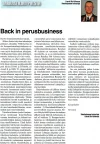Russia’s defense industry continues the development of the Derivatsiya-PVO antiaircraft artillery system equipped with a 57-mm gun, expert Vladimir Tuchkov writes in his article published by the Svobodnaya Pressa online news agency.
According to Burevestnik, the system will be second to none in the world. Ten companies are taking part in the ZAK-57 Derivatsiya-PVO SPAAG’s development, with Burevestnik as prime contractor developing its unmanned fighting module. An extremely important part is being played by the Tochmash Design Bureau that has developed a guided artillery projectile for the 57-mm gun. The projectile’s kill probability is close to that of air defense missiles - 0.8 for a subsonic small size-target engaged with two projectiles.
The Derivatsiya-PVO’s capabilities are not limited to those of an antiaircraft artillery or gun/missile systems only. The 57-mm weapon can be used against ground threats, including armor and manpower.
As for ZAK-57’s air defense role, it can handle targets of all types, including unmanned aerial vehicles (UAV), cruise missiles and multiple-launch rockets, at short range.
The novelty of the ZAK-57 is that it relies on the gun of a much larger caliber than the 30 millimeters being the caliber of other similar systems. Smaller-caliber weapons do not have sufficient range and are not that effective against present-day armored targets, but the principal advantage enjoyed by the 57-mm caliber is the gun’s guided-projectile ammunition. The development of the round was far more difficult than developing a similar round for the 152-mm Koalitsiya-SV SP howitzer.
Tochmash developed its guided projectile for the Burevestnik-improved artillery system based on the S-60 gun. The guided projectile’s airframe has the canard aerodynamic configuration. The round is loaded and fired in the same manner the ‘dumb’ rounds are. The projectile has four wings folded in the casing and controlled by the actuator in the projectile’s nose section, using the energy of the airflow. The laser sensor for guided the projectile to its target is in its rear and covered by a sabot that separates in flight.
The warhead weighs 2 kg, with 400 g being the weight of the high explosive. The HE’s weight corresponds to that of the HE of the organic 76-mm artillery projectile. A proximity fuse-equipped multifunction projectile is being developed for the ZAK-57 Derivatsiya-PVO that will be able to fire ordinary 57-mm fragmentation/tracer and armor-piercing rounds as well.
The guided projectile is fired via the rifled barrel toward the target or to a calculated set-forward point and is laser-guided. Its range is between 200 m and 6-8 km against manned aircraft and 3-5 km against UAVs.
The ZAK-57 has a TV/thermal-imaging system to acquire and track targets and to cue projectiles to them. The system has the automatic target lock-on and tracking capabilities, a laser rangefinder and a laser guidance system. The electro-optical control system affords the SPAAG the round-the-clock all-weather operating capability. The Derivatsiya-PVO can fire both on the move and at the halt.
The gun features a high rate of fire - 120 round per minute. The process of repelling air attacks is all-automatic from target acquisition to round selection to firing. The gun’s elevation varies from -5 deg. to 75 deg. The Derivatsiya-PVO reaches targets at an altitude of 4.5 km and eliminates lightly armored ground vehicles at a range of 3 km.
The SPAAG’s strengths include its low weight - just above 20 tons - that contributes to its high maneuverability, off-road ability, speed and buoyancy.



